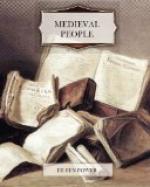18. The Monk of St Gall’s Life in op. cit., pp. 144-7.
19. Einhard’s Life in op. cit., p. 39.
20. Ibid., p. 35.
21. Beazley, Dawn of Modern Geography (1897), I, p. 325.
22. The Monk of St Gall’s Life in op. cit., pp. 78-9.
23. See the description in Lavisse, Hist. de France II, pt. I, p. 321; also G. Monod, Les moeurs judiciaires au VIIIe Siecle, Revue Historique, t. XXXV (1887).
24. See Faigniez, op. cit., pp. 43-4.
25. See the Monk of St Gall’s account of the finery of the Frankish nobles: ’It was a holiday and they had just come from Pavia, whither the Venetians had carried all the wealth of the East from their territories beyond the sea,—others, I say, strutted in robes made of pheasant-skins and silk; or of the necks, backs and tails of peacocks in their first plumage. Some were decorated with purple and lemon-coloured ribbons; some were wrapped round with blankets and some in ermine robes.’ Op. cit., p. 149. The translation is a little loose: the ‘phoenix robes’ of the original were more probably made out of the plumage, not of the pheasant but of the scarlet flamingo, as Hodgson thinks (Early Hist. of Venice, p. 155), or possibly silks woven or embroidered with figures of birds, as Heyd thinks (Hist. du Commerce du Levant, I, p. 111).
26. The Monk of St. Gall’s Life in op. cit., pp. 81-2.
27. This little poem was scribbled by an Irish scribe in the margin of a copy of Priscian in the monastery of St Gall, in Switzerland, the same from which Charlemagne’s highly imaginative biographer came. The original will be found in Stokes and Strachan, Thesaurus Palaeohibernicus (1903) II, p. 290. It has often been translated and I quote the translation by Kuno Meyer, Ancient Irish Poetry (2nd ed., 1913), p. 99. The quotation from the Triads of Ireland at the head of this chapter is taken from Kuno Meyer also, ibid. pp. 102-3.
CHAPTER III
MARCO POLO
A. Raw Material
1. The Book of Ser Marco Polo the Venetian concerning the Kingdoms and Marvels of the East, trans. and ed. with notes by Sir Henry Yule (3rd edit., revised by Henri Cordier, 2 vols., Hakluyt Soc., 1903). See also H. Cordier, Ser Marco Polo: Notes and Addenda (1920). The best edition of the original French text is Le Livre de Marco Polo, ed. G. Pauthier (Paris, 1865), The most convenient and cheap edition of the book for English readers is a reprint of Marsden’s translation (of the Latin text) and notes (first published, 1818), with an introduction by John Masefield, The Travels of Marco Polo the Venetian (Everyman’s Library, 1908; reprinted, 1911); but some of the notes (identifying places, etc.) are now out of date, and the great edition by Yule and Cordier should be consulted where exact and detailed information is required. It is a mine of information, geographical and historical, about the East. I quote from the Everyman Edition as Marco Polo, op. cit., and from the Yule edition as Yule, op. cit.




